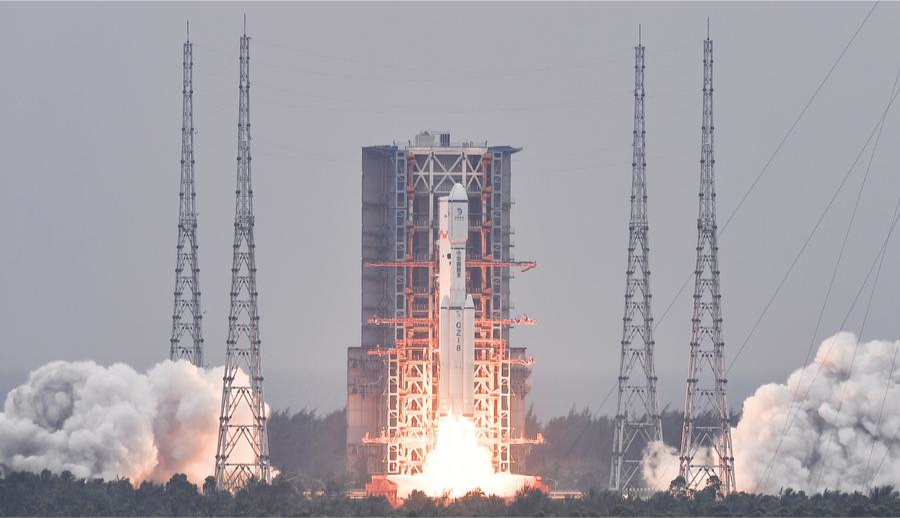China successfully deploys Queqiao
A Long March-8 rocket, carrying the relay satellite Queqiao-2 for Earth-Moon communications blasts off at the Wenchang Space Launch Center in south China's Hainan Province, March 20, 2024. [Photo/Xinhua] The Queqiao-2 satellite has recently completed in-orbit communication tests, with its platform and payloads working normally, according to the China National Space Administration (CNSA) on Friday. The functions and performance of Queqiao-2 meet mission requirements, and it can provide relay communication services for the fourth phase of China's lunar exploration project and future lunar exploration missions of China and other countries, said the CNSA, announcing the Queqiao-2 mission a complete success. The satellite successfully completed a communication test on April 6 with Chang'e-4, which is now carrying out an exploration mission on the far side of the moon. From April 8 to 9, it conducted communication tests with the Chang'e-6 probe, which is yet to be launched. Queqiao-2 was launched on March 20 and entered its target highly elliptical orbit on April 2 after midway correction, near-moon braking and orbital maneuver around the moon. Two communication and navigation technology test satellites, Tiandu-1 and Tiandu-2, were sent into space together with Queqiao-2. They entered their target circumlunar orbits on March 29 and separated with each other on April 3. They are now conducting a series of tests on communication and navigation technology. Queqiao-2, Tiandu-1 and Tiandu-2 all use a highly elliptical lunar frozen orbit as their target orbits. This kind of orbit is stable, ensuring the spacecraft travels with the minimum of trajectory deviation. This orbit can bring many advantages to Queqiao-2. Compared with Queqiao, which was launched in 2018 for Earth-Moon relay communications, the orbit of Queqiao-2 is closer to the moon, which greatly improves the communication rate of data transmission. Compared with Queqiao, which orbits around the second Lagrangian (L2) point of the Earth-Moon system, Queqiao-2 has also significantly improved its communication coverage on the south pole region of the moon. This orbit also helps the satellite save fuel, meaning that Queqiao-2 can stay in this orbit for a long time with very little fuel. Queqiao-2 will provide relay communication services for the Chang'e-4 lunar probe and the Chang'e-6 mission in the future as planned, and carry out scientific exploration at an appropriate time. The deployment of the Queqiao-2 relay satellite is a key step for China's future lunar exploration missions, including Chang'e-6, Chang'e-7 and Chang'e-8. The landing and sample collection sites of China's moon missions in the coming years are mainly in the lunar south pole region or on the far side of the moon. A more powerful relay satellite with more functions is necessary to provide communications and data transmission services for the missions. Chang'e-6 is scheduled for launch in the first half of 2024, while Chang'e-7 will be launched around 2026, and Chang'e-8 around 2028. Chang'e-7 and Chang'e-8 will form the basic model of a lunar research station to carry out lunar environment exploration, according to the CNSA. 
Related suggestion
Nicole Kidman's kids she shares with ex
RSCPA's wildly woke rebrand: As charity infuriates farmers and slams Brits killing snails
What would open warfare between Israel and Iran look like? How tit
US, UK intelligence leaders raise fresh alarms about Chinese espionage
Nepal general advocates enhanced China
Six people killed in Canada in rare mass murder case
- Recently published
- Susanna Reid says she is still 'very connected' to former co
- King Charles's call for all able
- Here's one we faked earlier! Portrait of late Queen Elizabeth II with her grandchildren and great
- Perfect for a 'slimmed
- Seeking engagement and purpose, corporate employees turn to workplace volunteering
- From deep sadness to dazzling pomp, 15 key revelations from the must
- LIZ JONES: Kate's strength has made me ashamed. And there's one self
- Who could have saved the Middletons' Party Pieces from disaster? A well
- Chinese premier meets Indonesian president
- Who could have saved the Middletons' Party Pieces from disaster? A well
- Random reading
- China's air passenger trips to reach 9 million during May Day holiday
- Who could have saved the Middletons' Party Pieces from disaster? A well
- A quiet birthday for Meghan's former best
- Let's hear it for Princess Anne, the brave, plain
- Strawberry Music Festival to be held at Beijing Expo Park
- Princess Beatrice and Edoardo Mapelli Mozzi are all smiles as they join his mother
- Meghan Markle purchased pair of £1990 diamond earrings from Dragons' Den hopefuls
- Kate and Charles' heart
- CBA playoffs: Shanghai crush Beijing to reach last eight
- HKFP Lens: Hong Kong through the eyes of photojournalist Wong Kan
- Listen up: Northland to test tsunami sirens
- U.S. dispatches general in charge of the Middle East to F
- 10 spotted seals released into ocean off northeast China city
- Mother, 24, outraged after learning shopping centre bathroom with baby changing facilities has CCTV
- Doctor reveals shocking theory behind why you suddenly need to use the toilet during shopping trips
- Time for some Royal R&R! King Charles and Queen Camilla arrive in Aberdeen for a restful
- Interstate near Arizona
- JAN MOIR: Why JK Rowling SHOULDN'T forgive the weaselly band
- Former drug dealer given second chance as dealer of pre
- She's known as the no
- Search
- LINKS
- Kazakh embroidery production helps female villagers increase income in Xinjiang
- Water use remains steady as GDP increases
- All eyes on Xiaomi car to see if it can trump rivals
- IDC: China's GenAI sector investment surges
- Xiaomi SU7 heats up EV segment
- 20th Shambhala Tourism Festival kicks off in Gansu
- Xi Meets Scholz via Video Link
- Tighter U.S. chip curbs prompting concerns
- Pic story of shadow play artist in Shaanxi
- People shop for decorations for upcoming Halloween in Ontario, Canada